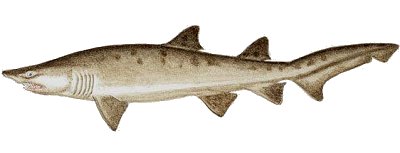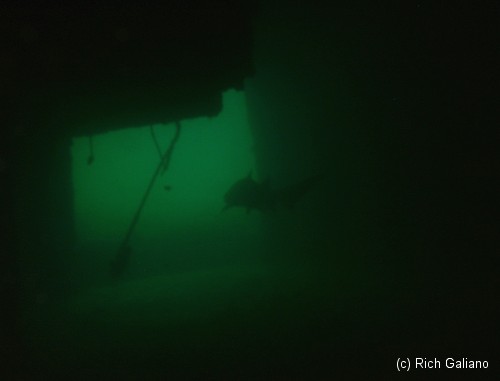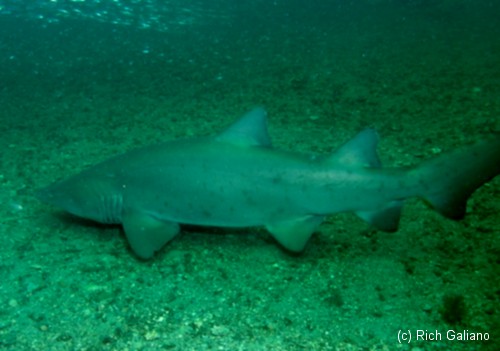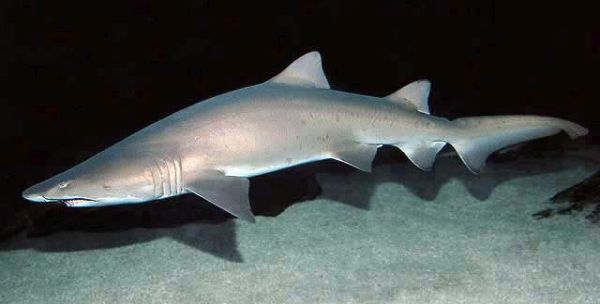Sand Tiger Shark

Carcharias taurus
Size:
to 11 ft
Habitat:
coastal waters
Notes:
dangerous if provoked, usually unaggressive
Sand Tiger sharks have a broad inshore distribution. In the Western Atlantic, this shark occurs from the Gulf of Maine to Florida, in the northern Gulf of Mexico, in the Bahamas, and in Bermuda. The sand tiger shark is one of at least four species belonging to the family Odontaspididae. Synonyms include Carcharias taurus, Eugomphodus taurus, and Carcharias arenarius.
The recognized FAO common name for this species is the sand tiger shark, but it is also known as the Gray Nurse shark in Australia and the Spotted Ragged-tooth shark in southern African waters. In Australia, this shark is considered to be dangerous. Perhaps the population there is more aggressive. ( The sharks, I mean. )

The long smooth dagger-like teeth of the Sand Tiger are designed for grasping small prey items, which are swallowed whole. Biology, therefore, makes this shark unlikely to attack something as large as a diver - it would simply not be able to eat it, and would probably lose a lot of teeth in the process.
The Sand Tiger shark has a very stocky body and is light brown to grayish color above, merging to off-white on the belly. Dark blotches or spots may occur on the upper two-thirds of the body, particularly in juveniles. It has a conical nose, a dorsally flattened head, and all five gill slits are located before the pectoral fin. A small pit is located on the upper side of the caudal peduncle. The teeth, which are similar in both jaws, are long and pointed, with a small spine-like cusp on either side. The first dorsal fin is situated immediately in advance of the ventral fins. The two dorsal fins and the anal fin are all approximately the same size, and the caudal fin has an elongated dorsal lobe. The maximum size of the species has been given variously as 9 feet and 300 lbs, and 11 feet and 600 lbs. Catch records from beach netting in Australia suggest that Sand Tiger sharks may grow to 14 feet. The oldest individuals recorded in aquaria were 13 years and 16 years.
Sand Tiger sharks occur either alone or in small to medium-sized schools. They have been observed hovering motionless just above the seabed in or near deep sandy-bottomed gutters or rocky caves, usually in the vicinity of inshore rocky reefs and islands, they are generally coastal, usually being found from the surf zone down to depths around 75 feet. However, they may also be found in shallow bays, around coral reefs, and to depths of 600 feet on the continental shelf. They usually live near the bottom, but may also be found throughout the water column.


This shark is a slow but strong swimmer that is usually more active at night. Although its body is more dense than the water, it has been found to swallow air at the surface and hold it in its stomach to maintain neutral buoyancy.
Mating occurs between late October and the end of November. Courtship may be a lengthy process which involves the males inflicting nips on the female. If she is receptive, mating follows. If not, the male continues biting, inflicting wounds all over her body until she flees. Full-term pregnant females move southward each year during July and August to give birth in early spring and then return northward. Not all migrating females are sexually active and mature females generally reproduce only once every two years.

This species is ovoviviparous ( meaning that they develop as unattached embryos within the uterus, with energy supplied by large egg yolks ) as opposed to viviparous ( live placental birth ) or oviparous ( laying egg cases - like skates ), and usually only one or occasionally two pups are born per litter. This is because the remaining eggs and developing embryos are eaten by the largest and/or most advanced embryo in each horn of the uterus ( uterine cannibalism ). The gestation period may last from 9 to 12 months, and the size at birth is relatively large, about three feet.
Sand Tiger sharks have been fished throughout their range, but are of variable economic importance regionally. The species is highly regarded as a food fish in Japan, but not in the Western Atlantic. It is caught primarily with line fishing gear, but is also taken in bottom-set gillnets and on pelagic and bottom trawls. The meat is utilized fresh, frozen, smoked and dried and salted, for human consumption. It has also been used for fishmeal, oil (from its liver) and its fins are used for the Oriental sharkfin trade. Sand tigers are very susceptible to fisheries because they aggregate in large numbers at particular coastal spots at certain times of year. These aggregations have been targeted in the past by fisheries. In addition, the juvenile Sand Tiger sharks are most common and dependent on some of the most polluted estuaries of the eastern US: the Chesapeake, Delaware, and Narragansett bays, and the Pamlico and Long Island Sounds. Interuterine cannibalism is another factor that makes this species vulnerable, since it limits the litter size to one or two pups.

Sand Tiger sharks have a fearsome battery of long curved needle-like teeth, which are usually on display as the shark typically swims with its mouth open. They adapt more readily than most large sharks to captivity and are popular subjects at public aquaria. Sand Tiger sharks are strictly protected by law.

